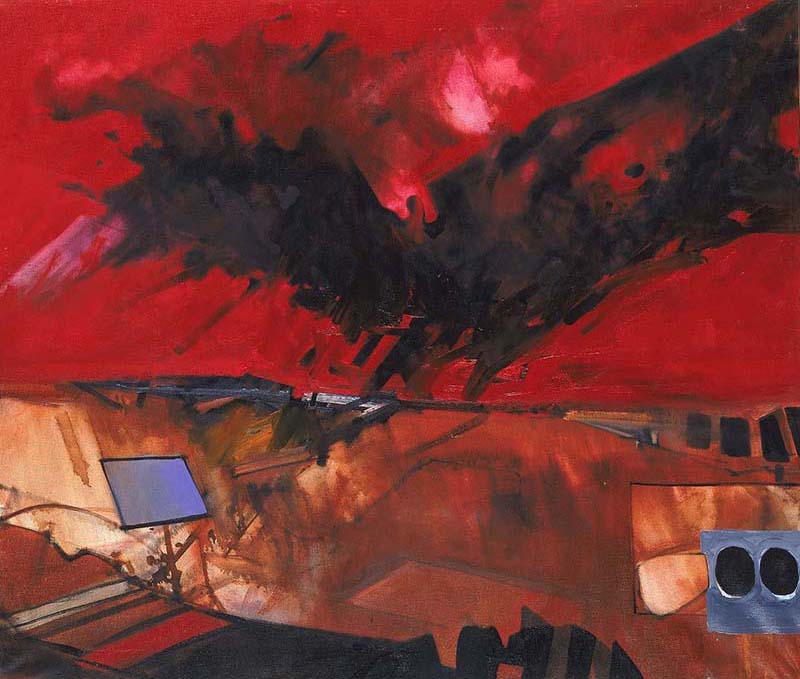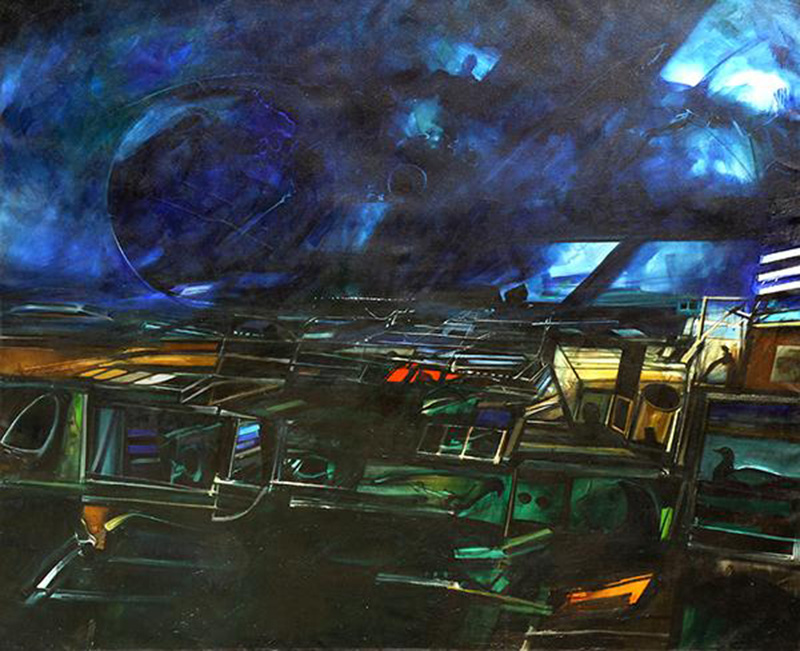And the Lord God formed man . . . and breathed into his nostrils the breath of life.
— Genesis 2:7The world is beautiful before it is true.
— Gaston BachelardThe theory of art developed in the Renaissance was intended to aid the artist in coming to terms with reality on an observational basis.
— Erwin PanofskyTell me! Is your universe awakening or going to sleep?
— John Hultberg
Cosmologists tell us that the temperature of space is two point seven Celsius above absolute zero. Certainly, many of Hultberg’s works, such as Twilight: Down The Drain and Dark Egypt, have icy light blue or very cold, dark blue skies. Demon Cloud, more demon angel than cloud, is certainly an exception with its infrared emissions glowing with the hot radiance of an unexplained fog of ions, or charged particles, over an accumulation of detritus. At right is a geometric plane with double circles, and at left is an easel-like speaker stand, both linked together by a single, cool, azure color. The demon cloud/angel, with its flurry of elegant brushstrokes that meld into the terrain, hovers over a landscape of tachist openings (and closings?) like dark kinetic energy escaping the gravitational field of earth. With his extraordinarily unique use of perspective, Hultberg expands his art into something more spatial, more astronomical, more cosmic.

Color carries emotional connotations: It exercises a direct effect on our nerve centers and hence on our emotional life. Red is positive and extroverted — it has more symbolism and associations than any other color. Just as blue beckons our spirit with vibrations of faith into infinite ethereal distances, red connotes vigorous physicality, even violence. Thus our ideas of red are linked with our feelings of warmth and life, as well as danger and blood, although Hultberg, an eminent strategist with color, has rendered paint here with a luminous and corporeal virtuosity.
Demons are frequently depicted as a force that may be conjured and insecurely controlled and are generally understood as devils, fallen angels, wicked spirits of madness and/or ecstasy. And like a cloud, they connote a link between heaven and earth. Keats, among others, objected that Newton destroyed the beauty of rainbows by explaining the origin of colors: “Philosophy will clip an Angel’s wings, . . . Unweave a rainbow;” and even Sweeney Todd was accorded the title, Demon Barber of Fleet Street in a 1936 film. From Satan, his incubi and succubi of the Malleus Maleficarum, to fallen angels, devils, and witches, to the Vampires, Frankensteins, and Draculas of our cinematic entertainment world: Demons are forever. We see no indication that Hultberg clipped his demon angel’s wings, or opposed Newton’s unweaving of rainbows. As he wrote in his poem, Astronomers:
You who comfort the stars in their shabby disarray,
Ordering chaos with your frantic searching glass,
. . .
Or do you fly like angels above your fear,
Intoxicated by the great creature’s respiration,
Knowing we’re closer to reward with each light year
We speed away from the crumbling center of its expiration?
Newton’s 17th-century physics still remain valid, but his universe, with its stately, eternal procession of inert, blind bits of matter is in contrast to Einstein’s evolving, violent cosmos. Quantum mechanics, “ordering chaos,” tells us everything is in a timeless state of becoming — or expiration. Could Hultberg be suggesting that the cosmos, as we understand it with our “frantic searching glass,” reigns as a by-product of human consciousness? wondering if matter, with its “crumbling center,” will survive infinity? Or do his glowing images characterize his state of being, his deep enthrallment with unbounded space?
The incongruous use of “twilight” in Twilight: Down The Drain is curious inasmuch as twilight, or l’heure bleue, is a traditional Romantic reference to a moment in time often inspiring philosophical reverie. But Hultberg’s deep blue ionosphere (no starry night, no sun or moon, no cottonelle-cumulus clouds or rainbows) is more like a dark field of ionized gas emitting energy in ultraviolet wavelengths. Color, like astronomical formulae, differential string theory, or mystic philosophies, can’t easily be manifested in words, but it may convey a sense of time, space, and place by reintegrating perceptually drenched memories and serve as a unique memorial function as taste or smell did for Marcel Proust. Hultberg’s voluptuous blues, like the action of light on our nervous system, awaken essential, receptive, and sensitive values within our being.
The perspective vectors of the sky and the detritus on the ground (provisions? storage equipment? stockpiles? or merely leavings and accumulations?) rush to an indeterminate but definite vanishing point — or is it merely a stopping point? The velocity of Hultberg’s vector field seems to displace the gravitational field of earth. There is a suggestion of blue ethereal figures or bodies (a couple?) in the thin, glacial atmosphere. Are they being sucked into some sort of dark hole? Is the recumbent figure at lower left a casualty? a sleeper? escapee? next in line for the dark hole? His is one of the few faces that confronts us; most of Hultberg’s figures, with their backs to us, challenge the ubiquitous horizon. Do Hultberg’s orthogonals signify an impending future with his deep perspective proscenium and great glut of objects — dancing figure, bodies, heads, faces, as well as circles (portholes?), squares, boxes, TV screens and/or panels evocative of paintings leaning against a partition?
Astrophysicists wonder whether the expansion of the universe will continue forever. If the life-friendly fine-tuning of our universe is just a chance occurrence, something that inevitably arises in an endless array of universes, is there any need for a fine-tuner — for a Great Respirator? Will galaxies continue to fly away from us or in some millennia bounce back in a reversal (a respiration?) of the cosmic expansion? Hultberg seems to suggest, in his “philosophic reverie,” the latter in this percipient painting with its radiant twilight cosmos. The essential element of the universe is space; its nature is “emptiness,” and because it’s vacant, it can contain everything. If outer space is closed, everything within would be reduced to insignificance and our fate to nonexistence — down the drain.

Light vibrations are a kind of inexpressive program sent out by an indifferent cosmos preparing the way for the cosmic aura of luminous color in Hultberg’s resonant Into the American Night (1964-68). A companion to Dark Egypt (1964-68, private collection), Into the American Night is dominated by a large, circular form (a globule of dust and gas in the cosmos? or a symbol of undivided wholeness?), and a fractured Cobalt or Prussian Blue firmament that seems to inhibit the transmission of light on either side. “The eye is the first circle,” Emerson wrote, “the horizon which it forms is the second,” but Hultberg’s firmament orthogonals and mystic landscape orthogonals seem to point to an indistinct horizon, which the eye forms with no suggestion of a vanishing point or an infinity. His non-horizon doesn’t seem to be a meeting of sky and earth, but rather a limit of one’s observation. The interior of his many circles, with no conceivable limit, signifies a persuasive psychic center. Hultberg’s sky is not so much a crack of doom as it is icy-blue, perspective-like vectors jetting toward a field of vision above a conglomeration of debris of windows, shutters, tables, etc. that seems to be more concerned with “the great creature’s respiration.” An ambiguous bird-like silhouette on the right peers innocently into Hultberg’s chthonian abyss.
In the 15th century, Alberti saw perspective as a geometric instrument for artistic and architectural representation on an observational basis; “It is perspective,” stated Panofsky, “that makes possible the metaphor of a Weltanschauung, a world view.” Unlike Alberti’s vanishing point, whose perspective served for the construction of a correctly unified, unobtrusive space, Hultberg’s unusual perspective depicts space as a realm without intrinsic dimensions, with no reality of its own. Making heretical use of the Renaissance convention of linear perspective, Hultberg created deep, global, illusionary panorama-scapes, peopled with fragmented objects and visionary personages.
Certainly, quantum mechanics, ruled by equations, can lead to the view that fields or electromagnetic relationships alone are real and explain that what we call panorama-scapes, objects, and personages, are really patterns in the cosmic process. The universe in which we live is of a piece; there is no structure of human thought, no human activity that does not bear heavily on every other structure or activity. Wrought by the Great Depression as a child and marked by the Atomic Era as an artist, Hultberg’s revelations and illuminations came within and through experience. He had “a world view” and was concerned with Mankind in comparison with the Infinite. Steeped in humanistic values and filled with the revelation of deep feeling rather than ephemeral sensation, he wrote in Astronomers:
Tell me! Is your universe awakening or going to sleep?
How long can you its worn-out secret keep?
It is heartening that a thoughtful, erudite, and painterly mind was at work in our time. John Hultberg (1922-2005), artist, poet, visionary humanist, created his own respirations. •
Images courtesy of Smithsonian American Art Museum, Clars Auction Gallery, and 3rd foundation via Flickr (Creative Commons)




